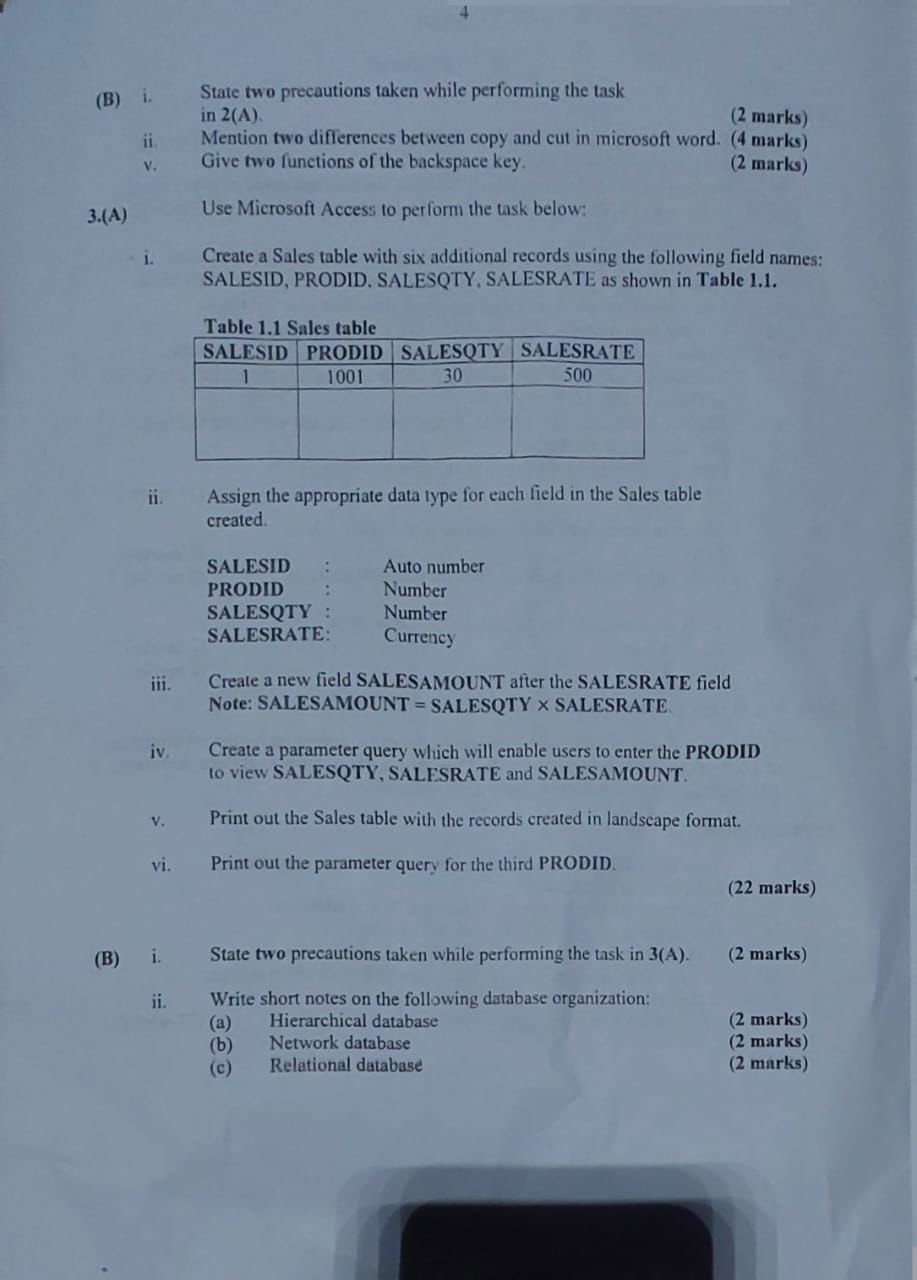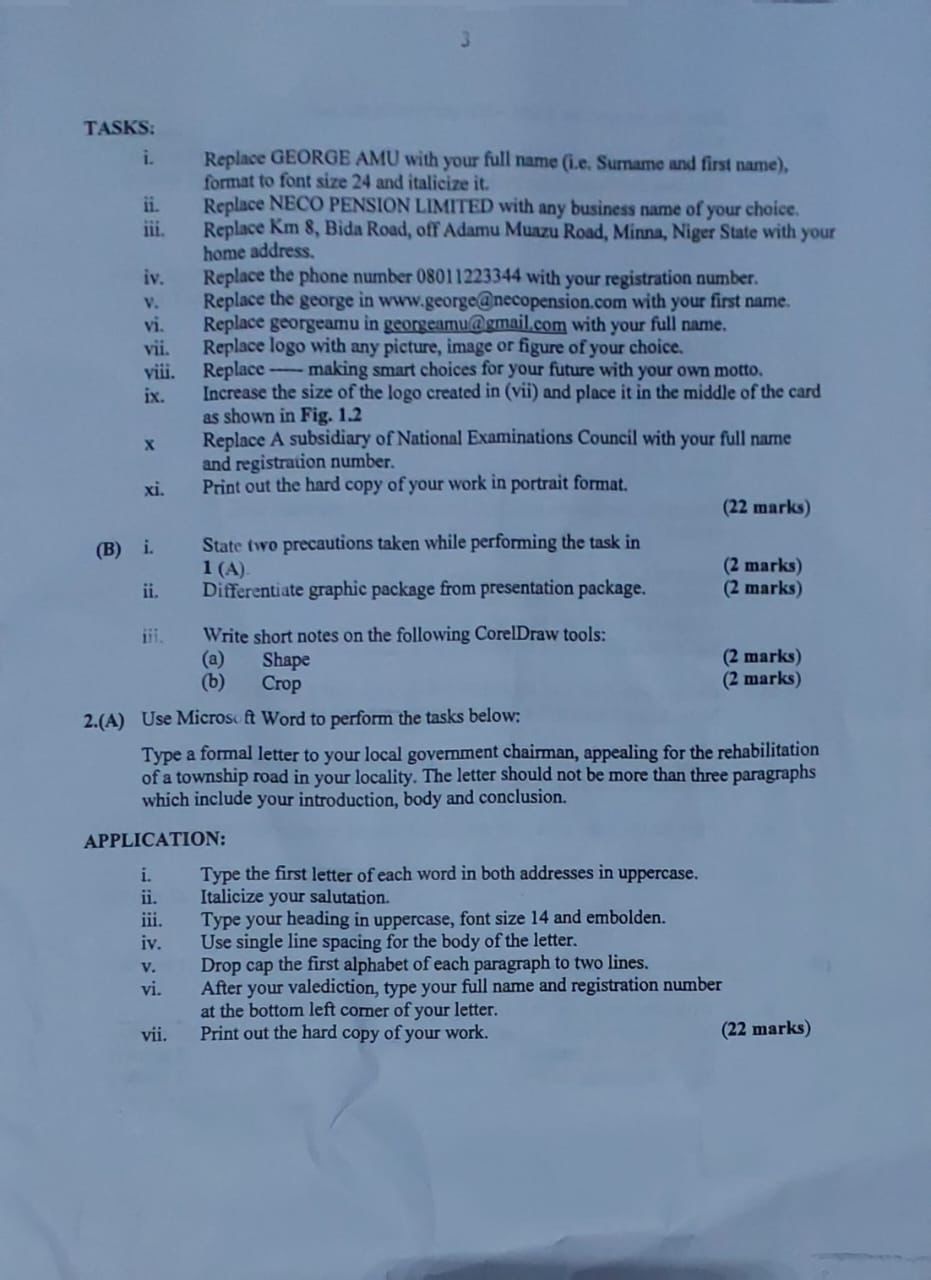
This is to inform all students preparing for the 2024 NECO SSCE exams and the school administrators that the June/July NECO Data Processing practical Questions and Answers for 2024 are now available. The exam will commence on Thursday 11th July 2024.
====================================
NECO 2024 Update
Remember
You can still subscribe for NECO.Important
The price will go up next week!Subscribe Now
Pay now and get:
Added to NECO VIP Group
Answers sent to you from midnight
Subscribe now, don’t delay!
NECO 2024 DATA PROCESSING PRACTICAL QUESTIONS AND ANSWERS | June/July EXPO:
Paper I Practical – Data Processing (2 hrs) (10:00 am – 12:00 noon)

NOTE: NECO June/July 2024 Free Practical – Data Processing Question and Answer Room: Pay just N1,500! Click on the link below to WhatsApp us and get the answers at 12 midnight. Prepare effectively and ensure your success in the exam with our comprehensive resources.
CLICK HERE TO GET FULL QUESTIONS AND ANSWERS
2024 NECO DATA PROCESSING PRACTICAL ANSWERS
*-No. 1bii-*
Graphic Package:
– A collection of visual elements, such as logos, icons, graphics, and images, designed to represent a brand or product.
– Typically includes various file formats (e.g., PNG, JPEG, SVG, EPS) and different resolutions.
– Used for branding, marketing materials, and visual identity.
Presentation Package:
– A set of visual aids, such as slides, graphs, charts, and images, designed to communicate information or tell a story.
– Often created using presentation software like PowerPoint, Google Slides, or Keynote.
– Used for presentations, meetings, conferences, and sales pitches.
================================
-No. 1biii-
a] *Shape Tool:* Used to create and edit vector shapes, such as rectangles, ellipses, and polygons. It allows manipulation of nodes and curves to modify the shape.
b] *Crop Tool:* Used to trim or mask an object or image to a specific shape or size. It removes or hides parts of the object outside the crop area, without affecting the original shape.
============
*2bii]*
*Copy:*
– Duplicates the selected text or image, leaving the original in place.
– The copied content is stored on the clipboard, allowing you to paste it elsewhere in the document or in a different application.
*Cut:*
– Removes the selected text or image from its original location.
– The cut content is also stored on the clipboard, allowing you to paste it elsewhere in the document or in a different application.
(2)
JUST FILL IN YOUR NAME AND REG NUMBER UNDERNEATH ✔️

(3bii)
(a)A hierarchical database is a type of database that organizes data in a tree-like structure, with each record having a single parent record and multiple child records. This structure is similar to a file system, where directories and subdirectories are organized in a hierarchical manner.
KEY FEATURES OF HIERARCHICAL DATABASES:
(i)Data is organized in a tree-like structure
(ii)Each record has a single parent record and multiple child records
(iii)Relationships between records are represented as links between nodes
(iv)Data is stored in a series of segments, each containing a group of related records
(v)Supports fast data retrieval and efficient data storage
EXAMPLES OF HIERARCHICAL
(i)IBM’s IMS (Information Management System)
(ii) Windows Registry
(iii) XML (Extensible Markup Language) documents
*(B)* A network database is a type of database that organizes data as a network of interconnected records, allowing for multiple relationships between records. This model was developed to overcome the limitations of hierarchical databases.
IN A NETWORK DATABASE:
(i)Data is stored as a collection of records, called nodes or segments
(ii)Each record has multiple parents and children, forming a web-like structure
(iii)Relationships between records are represented as links or pointers
(iv)Each record can have multiple owners and multiple members.
FEATURES OF NETWORK DATABASES
(i)Multiple relationships between records
(ii)Flexible data modeling
(iii)Efficient data storage and retrieval
(iv)Support for large-scale applications
EXAMPLES OF NETWORK DATABASES
(i)IDS (Integrated Data Store)
(ii)IDMS (Integrated Database Management System)
(iii)Network models like the CODASYL (Conference on Data Systems Languages) model
*(C)* A relational database is a type of database that organizes data into one or more tables, with each table having rows and columns, similar to an Excel spreadsheet. Each row represents a single record, and each column represents a field or attribute of that record.
IN A RELATIONAL DATABASE:
(i)Data is stored in tables, with each table having a unique name
(ii)Each table has rows (records) and columns (fields)
(ii)Data is manipulated using SQL (Structured Query Language)
Also Relational databases follow the relational model, which was introduced by Edgar F. Codd in 1970. The model is based on the concept of relational algebra, which uses mathematical operations to manipulate data.
FEATURES OF RELATIONAL DATABASES ARE:
(i)Data normalization
(ii)Data integrity
(iii)Data consistency
(iv)Support for querying using SQL
EXAMPLES OF RELATIONAL DATABASES
(i)MySQL
(ii)PostgreSQL
(iii)Microsoft SQL Server
(iv)Oracle
=============
================================
2024 NECO DATA PROCESSING PRACTICAL QUESTIONS
================================


================================
2024 NECO Data Processing (Practical) Questions –Specimen
====================================
Recommended post:
100% Verified NECO Mathematics Solutions for June/July 2024 (Essay & OBJ)
